AMD Trinity (A10-4600M) Review
AMD Trinity (A10-4600M)
We put AMD's new laptop chips to the test - is this the dawn of a new AMD era for laptops?
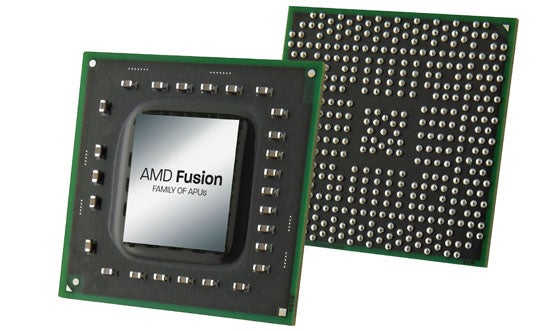
Verdict
AMD has long played second fiddle to Intel when it comes to providing the chips that power our laptops. Plain and simply, Intel has nearly always offered a better balance of battery life and performance. Last year AMD unveiled its codenamed-Llano chips, which packed in class leading graphics performance but still trailed when it came to real world battery life and CPU performance. Now the company is back with its latest codenamed-Trinity chips, and the claims as to its abilities are bold indeed. Not only should its Radeon HD 7000 graphics comfortably beat both Intel’s existing ‘Sandy Bridge’ based chips and latest ‘Ivy Bridge’ mobile range but also it should have great battery life and CPU performance too.
We’ve spent some time with a test laptop based on the new AMD A10-4600M chip to see just how it stacks up in real world usage. We’ll be putting it to the test later on but first a few more details about Trinity.

AMD Trinity Architecture
AMD Trinity is the codename for the company’s new range of what it refers to as its APUs (Accelerated Processing Units). AMD uses this terminology because unlike CPUs of old, these new chips don’t just house the main processor but the graphics processor (which itself can be used for computing tasks other than graphics), memory controller and a number of dedicated units for speeding up things like video decoding. It’s technically still the Central Processing Unit (CPU) of the whole system but it also does so much more.
Intel has done a very similar thing with its chips, which is why we’re able to see the sorts of thin, light and powerful laptops that are around today – it just doesn’t refer to them as APUs quite so readily.
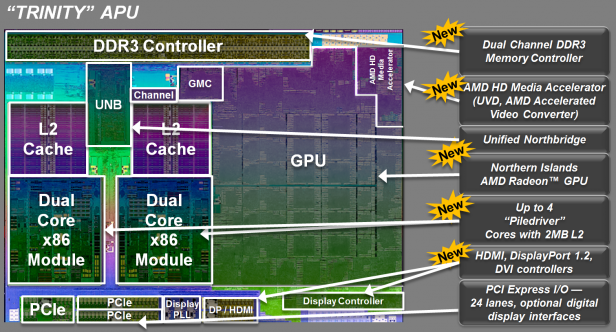
The Trinity chips will combine either two or four CPU cores with up to 384 graphics cores on a single piece of silicon, resulting in a 1.303billion transistor chip. This is just a fraction more than Llano (1.170billion) while die size has also gone up a smidgen from 228mm^2 to 246mm^2. In comparison, Intel’s Sandy Bridge uses a 216mm^2 die with 1.16billion transistors and Ivy Bridge and has a die size of 160mm^2 with 1.4billion transistors.
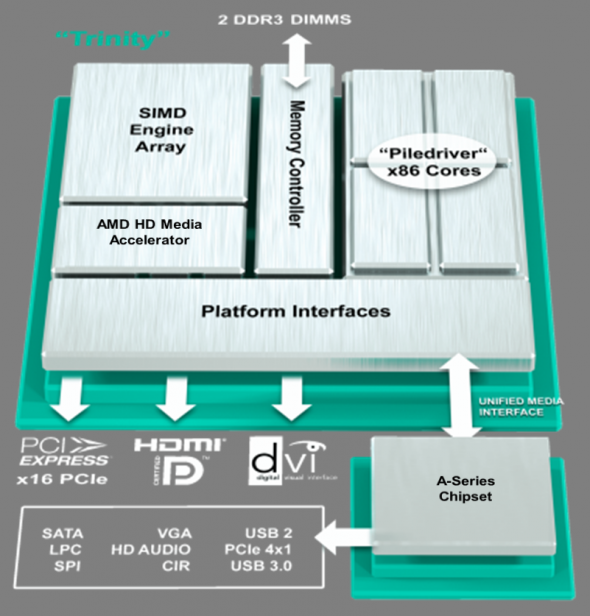
Trinity is built using AMD’s existing 32nm manufacturing process, just as with its Llano chips but despite this it has managed to double performance-per-watt while both CPU and GPU performance increase is in the double digits. This 32nm is roughly an equivalent generation to Intel’s Sandy Bridge but behind its just-about-arriving-now Ivy Bridge chips which use a smaller and more power efficient 22nm process.
AMD Piledriver
The beating heart of Trinity is the Piledriver CPU core, which replaces the Stars based design of Llano. Direct comparison is a little tricky as each Piledriver ‘module’ contains what is roughly equivalent to two normal cores, though not quite. The chips will come with either one or two modules making for what are essentially either dual or quad core chips.
We won’t dive too deep into the architecture here (Anandtech has done a great deep dive of the tech if you’d like to read more) but the key is that it’s an almost completely new design, which offers both performance and power saving benefits. However, AMD readily admits it still can’t compete with Intel for raw CPU performance for any given Thermal Design Power (TDP – the maximum heat/power the chip is designed to output), and is relying on its chips delivering ‘enough’ performance in this area while backing it up with excellent graphics and media acceleration performance, and good battery life (low power usage).
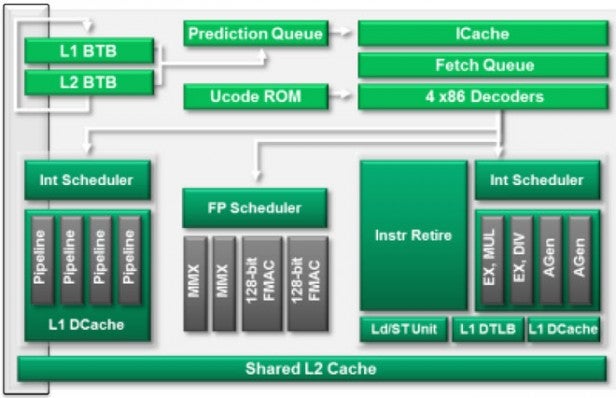
It’s a sound logic and one that certainly reflects the usage pattern of our times. After all, most people spend the majority of their laptop time performing relatively idle tasks like web browsing, writing and watching video, not performing intense calculations or doing heavy multitasking. It’s often only gaming that really calls upon a CPU/graphics chip to pull its weight. We’ll talk more on this point a bit later though.
Buried within the silicon there are a whole host of other tweaks and improvements that should result in lower power usage and better performance but one of the more prominent is the new AMD Turbo Core 3.0 technology.
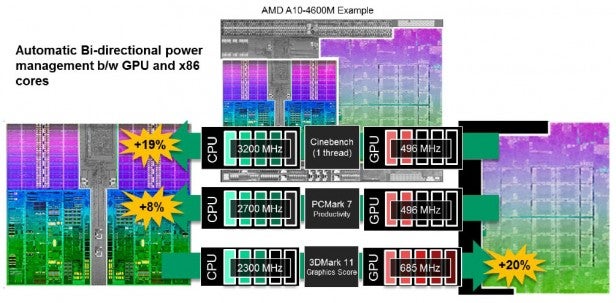
Turbo Core existed on Llano where it dynamically adjusted the clock speed of the CPU depending on workload, to get the most performance when needed without overheating the system. But it only worked on the CPU, not the GPU. With Turbo Clock 3.0 the chip can increase or reduce the clock speed of both as and when required. The algorithm for doing this is also much improved so that the chip really does eek out every last morsal of performance where it can.
On the flip side, in idle moments the chip can also power down almost completely to extend battery life, indeed AMD is claiming superior idle battery life to Intel.
AMD Radeon HD 7000 Graphics
Key to the appeal of this new AMD trinity range is its graphics capabilities. Each model in the range has a slightly different configuration, unlike Intels’ Sandy Bridge (Intel HD 3000) and Ivy Bridge (Intel HD 4000) chips which largely use identical configurations within each range. Confusing though this makes it, one thing should hold true, which is that we expect to see most of these AMD configurations beat both Intel Sandy and Ivy Bridge equivalents. We shall have to wait until the lower power products come to market before we can test this though. Also, whether this results in truly playable framerates in demanding games, we shall see, but at least less stressful titles should perform better.
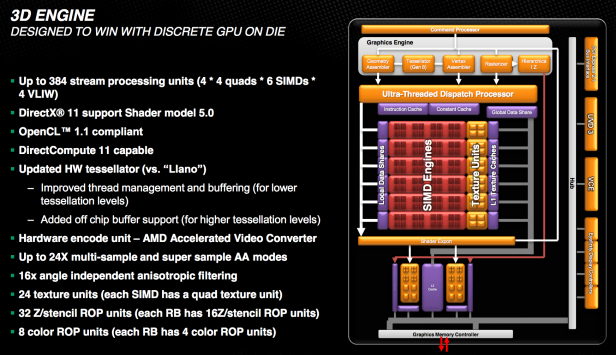
What makes these parts potentially really exciting, though, is that they can be partnered with extra graphics chips from AMD’s 7000 series mobile graphics range. If configured in the same system the two can work together, just like Crossfire/SLI in a desktop system. We haven’t had a chance to test this here but figures provided by AMD show a near doubling of performance over the APU alone. Meanwhile, when the system is idle the extra GPU should consume almost no power so should have minimal impact on performance. Again, all this we’ve yet to test, though, and there’s no guarantee we’ll see genuinely thin and light laptops with this sort of power.
As to the GPU itself, it’s very much similar to AMD’s latest desktop graphics cards in terms of fundamental design, just with less of everything. At most it will contain 384 cores, with the lower end parts dropping to 192 cores. These will be accompanied by up to 24 texture units and 8 ROPs, making the high-end part very roughly equivalent to ¼ of an AMD Radeon HD 6970 desktop card.
HD Media Accelerator
Rounding out the key features of the new design is the HD Media Accelerator. This is a block of the chip dedicated to speeding up certain tasks like video decoding – something which is supported in all the major browsers, Windows Media Player and VLC – and encoding.
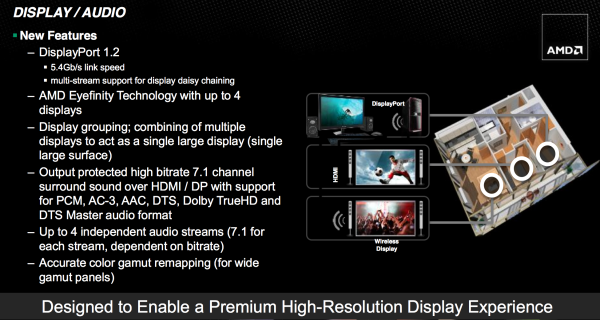
AMD is also touting its OpenCL support, which sees applications such as the above, Photoshop CS6, receive increased performance from intensive tasks being taken on by the GPU rather than the CPU.
There’s also AMD’s Quick Stream technology. This prioritises media-related internet traffic for smooth streaming video playback. Clearly this is largely reliant on your network connection still but if you’ve other apps accessing the internet, this technology will ensure they don’t disrupt your viewing.
AMD A-Series APUs
The new Trinity APUs will be coming to market as the A-series, with models ranging from the top performing A10 to the A6. This is a little confusing as the previous generation chips were also called the A-series, so you’ll have to check out full model numbers to differentiate – Llano used Axx-3000 style numbering, Trinity will use Axx-4000 numbering.
Within the numbering differences there are also some key feature differences. The chips will be available in two main configurations based on the type of mounting package they use: PGA or BGA. The standard set of APUs use the classic Pin Grid Array (PGA) arrangement where the chip is housed on a mounting that has hundreds of pins on its underside to connect to the motherboard. Meanwhile Ball Grid Array (BGA) uses tiny balls of metal instead of pins to make for an even smaller overall package.
Within each type of package there were also be differentiation based on the TDP of the chip, with 35W chips available for the larger PGA package and 25W and 17W for the BGA package. As you might expect, the former will find their way into larger more powerful laptops while the latter will be used in slimmer, even Ultrabook-style form factors.
Each configuration also has slightly different graphics capabilities. The full list of available versions is below.


AMD Trinity Test Platform
So onto the crux of the matter – how do these new chips perform when in an actual laptop?
We were provided with a test laptop running the range topping A10-4600M APU. This had been crammed into a 14in chassis, but far from being a sleek and portable slice of desire, it’s a fairly utilitarian looking largely plastic slab that’s well over an inch thick. Still, it’s only meant for testing the underlying hardware and what’s more within that frame it has a Blu-ray drive, VGA and HDMI video outputs, two USB 3.0 ports, one USB 2.0 port, an ExpressCard slot, a memory card reader, Ethernet and both headphone and microphone jacks. It also has 4GB of RAM and a 128GB SSD. Consider the space you could save taking out the Blu-ray drive, and several of those ports and you could conceivably make a relatively slim machine with this core hardware configuration.
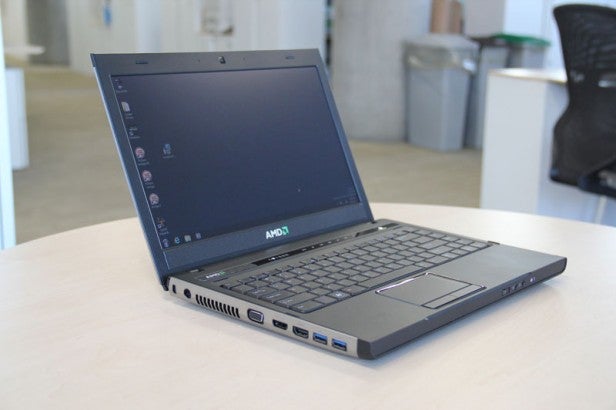
The combination of the high-end chip and SSD means this machine should outperform a great many equivalently sized laptops, and is perhaps a little unreflective of the sort of system you’re likely to encounter but it still gives us a strong indicator of real world performance. Literally powering the system is a 4400mAh battery, which is about typical for this size of machine.
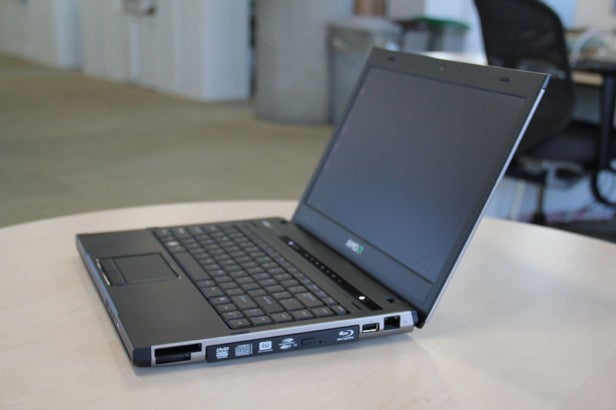
Now, finding a system to compare this one to was a bit tricky as few systems pack quite the same balance of components but we’ve picked what we think is a reasonably representative set. We’ve got a lower power Sandy Bridge chip being used by the archetypal Ultrabook the Asus ZenBook UX31, the a more direct competitor with a faster Sandy Bridge in the Lenovo ThinkPad X220 and finally we’ve chosen a superfast, quad core Sandy Bridge equipped HP Pavilion dv7-6b51ea Beats Edition desktop replacement laptop that also includes a dedicated AMD Radeon HD 6490M graphics card.
We’ll fess up that we simply haven’t been able to source an Ivy Bridge test system for comparison in time for this review but we’ll of course revisit the topic when we get our hands on an Ivy Bridge system. Having perused various other sources, we also have a good grasp on what we’re likely to see for CPU, GPU and to a certain extent battery life from such systems too.
Here’s the full comparison list:

So without further ado, onto the testing!
CPU Performance
First of our tests was the classic Cinebench. It’s a reliable indicator of the pure grunt of a CPU, which fully taxes both single and multi-core processors.
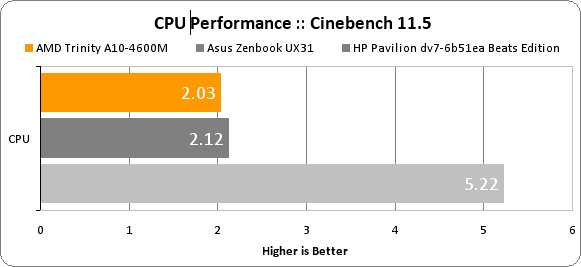
It’s immediately obvious just where the AMD A10-4600M’s deficiencies lie. With a Cinebench CPU score of 2.03pts, it just about matches the low power Sandy Bridge chip of the Zenbook but is utterly trounced by the more powerful HP. As for Ivy Bridge, it should come as no surprise that scores we’ve seen
suggest it pulls out even more of a lead over the HP here, with a scores of 6.5 being bandied around.
We also ran the general system performance test, PCMark 07, which showed AMD trailing both the Lenovo and Zenbook – the HP’s score is low as it uses a hard drive rather than SSD. Ivy Bridge scores for PCMark07 we’ve seen are in the region of 6500, again showing just how fast that chip can be.
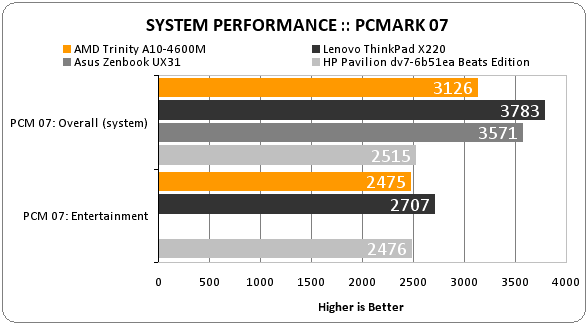
However, the key here is that AMD has indeed judged things correctly in terms of day to day use. Subjectively the A10-4600M feels plenty fast enough, providing nippy web browsing, smooth video playback and ample productivity performance. After all, Ultrabooks like the Asus Zenbook are considered more than usable and the A10 is on par.
GPU Performance
Turning to gaming, we used our classic notebook gaming benchmarks on this and our other comparison systems and the results are striking to say the least. In the relatively undemanding TrackMania Nations Forever test the A10 is neck and neck with the dedicated AMD graphics card on the HP, and holds a comfortable lead over both the Lenovo X220 and Zenbook. But TrackMania, at the settings we run, is so undemanding that it actually becomes limited by the CPU speed and it’s only in Stalker: Call of Pripyat we see the true picture. Here the A10 has a 60 per cent performance advantage over the HP’s AMD Radeon HD6490M graphics card, while the two Sandy Bridge systems are left far behind.
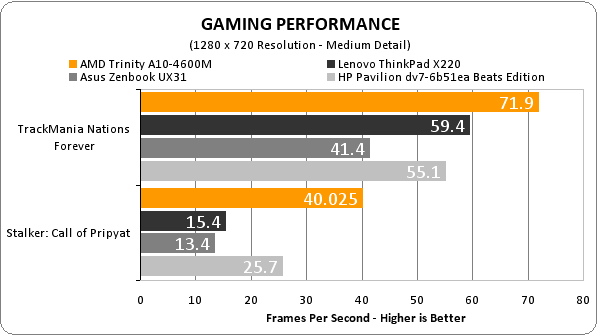
Does this result in a genuinely enjoyable real world gaming experience? Well, it’s a close one. While 40fps in Stalker is impressive, it’s only being run at medium detail settings and a resolution that’s lower than the number of pixels on your average laptop. Performance probably needs to double again before we’re really getting to a gaming-grade machine for even the latest games.
Nonetheless, less demanding favourites such as Counter-Strike: Source, World of Warcraft and Call Of Duty should all prove playable.
Battery Life
Perhaps the biggest shock, at least according to our tests is just how little power the A10-A4600M consumes, or more specifically how long this test platform’s battery life is. Despite housing the most powerful chip in AMD’s new range it comfortably beat both the Zenbook and the HP gaming machine, providing nearly an extra hours use, despite having the smallest battery on test. Only the X220 beat it, but that laptop has a 60 per cent bigger battery.
Our test uses the industry standard MobileMark Productivity test, which simulates a reasonably typical usage pattern of the user editing some documents, browsing the web, creating a powerpoint and watching some video, all interspersed with pauses to simulate the user sitting and having a think. We’ve found it to be a very good indicator of battery life in average use but there are some other extreme use cases where it is less indicative, in particular if you’re watching video – say on a long haul flight – or playing games.
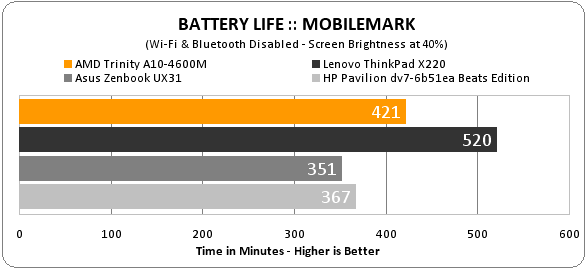
With regards the latter, it simply isn’t sensible to test battery usage as the GPU on any machine will drain power very quickly. However, watching video is something that other machines can do for hours on end, and here Trinity trails slightly, with the test platform providing around 3.5 hours of h.264 video playback compared to around 5.5 on the Zenbook. But, of course, here the argument comes back to this being a higher power chip, and the lower power Trinitys may still improve on this.
What we can say for certain is that AMD is definitely within touching distance of Intel on the battery life front.
Verdict
There are still key questions to be answered about the AMD Trinity platform, such as how the lower performance parts will fare and what sort of systems we’ll see sporting the new chips. Not to mention how much those systems will cost. But, on the evidence here it would appear AMD has done most of what it can. CPU performance does still trail both Intel Ivy Bridge and Sandy Bridge but crucially is ample for general day to day computing. Meanwhile GPU/gaming performance is class leading and battery life is at least on par. Is this the dawn of a new AMD-dominated era for laptops? Perhaps not, but no longer should we be confined to a choice of one.
How we test laptops
Unlike other sites, we test every laptop we review thoroughly over an extended period of time. We use industry standard tests to compare features properly. We’ll always tell you what we find. We never, ever, accept money to review a product.

